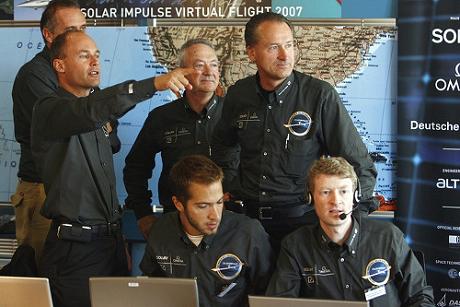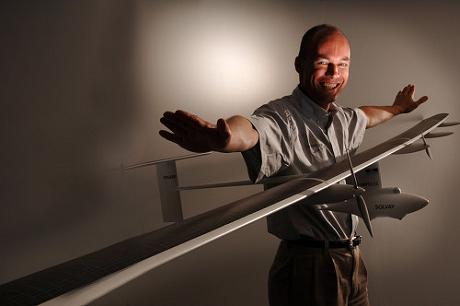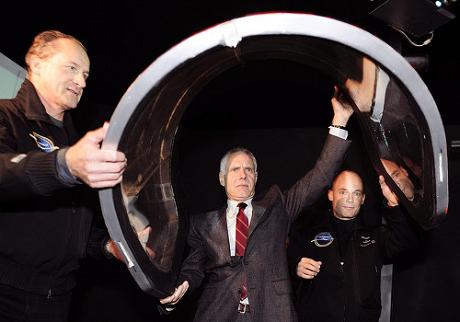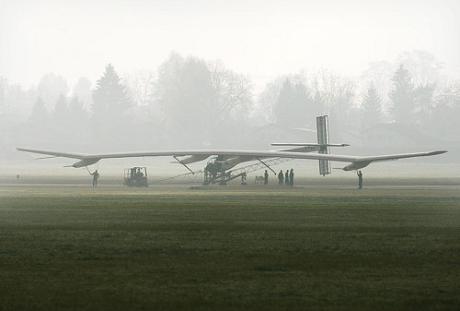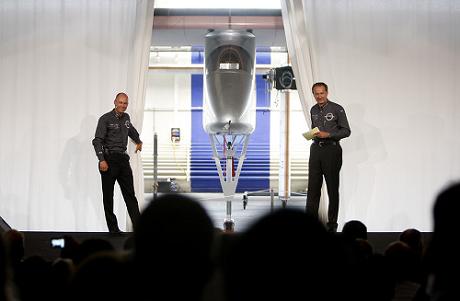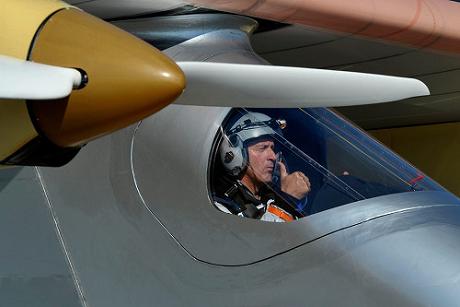The huge solar dragonfly made a final historic loop over Payerne airfield then gently glided onto the runway to loud applause – just over 26 hours after taking off.
The experimental solar-powered plane, known as Solar Impulse, landed safely at 9am on Thursday after completing its first night test flight, powered only by solar energy stored during the day.
The organisers said it was the longest and highest flight in the history of solar aviation.
Helpers rushed to steady the revolutionary aircraft as it stood on the tarmac, ensuring that its giant wings did not scrape the ground and topple it over.
Swiss pilot André Borschberg then slowly emerged, exhausted but jubilant, from the narrow silver cockpit to a hero’s welcome.
“Up there was incredible,” he told reporters. “It was a very zen flight – unbelievably peaceful. I felt that I’d been away for a very long time.”
Take-off
Borschberg, a former Swiss air force pilot who has flown for 40 years, took off from Payerne airfield, north of Lausanne, into the clear blue sky shortly before 7am on Wednesday, allowing the plane’s 12,000 solar panels to soak up lots of sunshine.
Flying in long gentle loops over the Jura Mountains, west of the Swiss Alps, the huge prototype, with its 63.4-metre wingspan – the equivalent of an A340 Airbus, but weighing only 1,600kg - climbed steadily throughout the day at an average speed of 42.6km/h.
The plane reached its maximum altitude of 8,535m at sunset, when a decision was made to continue through the night using solar power stored in its batteries.
Avoiding low-level turbulence and thermal winds, and enduring freezing conditions, the 57-year-old pilot made a slow descent, always within gliding range of Payerne, to an altitude of 1,500m.
“To see daylight disappear on the horizon and the artificial lights on the Plateau region was magical,” he said. “Of course the night is quite long, so to see the first rays of dawn and the sun returning in the morning - that was a gift,” Borschberg said after landing.
No first-class travel
"We achieved more than we wanted. Everybody is extremely happy."
- André Borschberg |
To keep him going while up in the air the Swiss munched on high-energy bars, homemade sandwiches, French rice pudding and drank coffee.
With no automatic pilot, Borschberg had to remain alert, supported by an army of ground control crew at the airfield. And with no one to take over the controls (and no toilet), he had to use a plastic bottle when nature called.
The former fighter pilot told swissinfo.ch he had also relied on yoga to keep blood circulating in his muscles and special breathing techniques so that “when I get low the energy comes back”.
But technology had also been at hand. Had Borschberg nodded off or even slightly loosened his grip on the controls, his jacket sleeves would have vibrated if the aircraft tilted beyond five degrees.
Bertrand Piccard, the Swiss co-founder of the project, also revealed another detail that kept Borschberg from snoozing.
"We didn't install a first-class [airline] seat, we installed a low-cost seat," he said.
Perpetual flight?
The historic flight completes seven years of planning and brings the Swiss-led project one step closer to its goal of circumnavigating the globe using only energy from the sun.
Earlier flights included a "flea hop" and a longer airborne test earlier this year, but this week's attempt was described as a "milestone" by the team.
"We achieved more than we wanted. Everybody is extremely happy,” said Borschberg.
In theory the single-seat plane can stay in the air indefinitely, the team claims, recharging its batteries using solar cells and nothing but the rays of the sun during the day.
Piccard said the success of the flight showed the potential of renewable energies and clean technology.
“We are on the verge of perpetual flight," he said.
No time to relax
But while he says this proves that emissions-free air travel is possible, he does not see solar technology replacing conventional jet propulsion any time soon. The project's main purpose is rather to test and promote new energy-efficient technologies.
The team will now set its sights on an Atlantic crossing, before attempting a round-the-world flight in 2013, making only five stops along the way.
Design work will begin next month on a second plane.
Among the changes, the cockpit must be adapted to accommodate a pilot for five days and nights. The plane must have better aerodynamics and provide improved flight performance. It must also have different landing gear to be able to land anywhere in the world. But they might use the same wing, which is glazed with solar cells.
"It's absolutely not time to relax," said Piccard.
Photos of the first manned, solar powered airplane
and the men who built and flew it
|
|
| Computer illustration of the Solar Impulse plane in 2006. |

